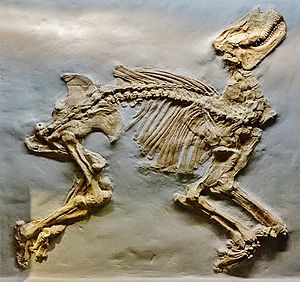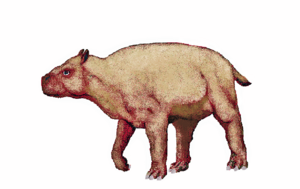Scarrittia facts for kids
Quick facts for kids Scarrittia |
|
|---|---|
 |
|
| S. canquelensis fossil | |
| Scientific classification |
|
| Kingdom: | Animalia |
| Phylum: | Chordata |
| Class: | Mammalia |
| Order: | †Notoungulata |
| Family: | †Leontiniidae |
| Genus: | †Scarrittia Simpson 1934 |
| Type species | |
| †Scarrittia canquelensis Simpson 1934
|
|
| Species | |
|
|
Scarrittia was an ancient mammal that lived in South America about 30 million years ago. It belonged to a group of hoofed animals called Leontiniidae. Imagine an animal that looked a bit like a rhinoceros but had a longer body and neck – that was Scarrittia! This animal is now extinct, meaning it no longer lives on Earth.
What Was Scarrittia Like?
Scarrittia was quite a large animal, growing up to about 2 meters (6.5 feet) long. It had a body shape similar to a rhinoceros, but with a longer body and neck. Each of its feet had three toes, and all of them ended in hooves. Scarrittia also had a very short tail.
A special feature of Scarrittia was that two bones in its lower leg, the tibia and fibula, were fused together. This meant it couldn't turn its legs sideways very well. Its head was short, and it had 44 teeth that weren't specialized for eating just one type of food.
Scarrittia's Life and Habits
Scarrittia was a very successful group of animals, with different kinds of species known today. These include Scarrittia robusta, S. barranquensis, and S. canquelensis. They lived around 30 million years ago during a time called the Oligocene epoch.
These ancient mammals preferred to live in wet, forested areas. They could be found near coasts, lakes, and swamps. Their diet mainly consisted of soft plants, grasses, fruits, and parts of trees. Some types of Scarrittia were omnivorous, meaning they also ate things like eggs and small mammals. Because of their large size, they didn't have many enemies, even though they weren't built for fast running.
Where Did Scarrittia Live?
Scientists have found fossils of Scarrittia in different places in South America. These fossils help us learn about where these animals once roamed.
Fossils of Scarrittia have been found in:
See also
 In Spanish: Scarrittia para niños
In Spanish: Scarrittia para niños


